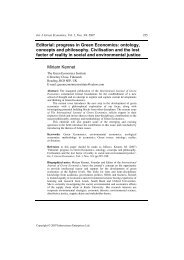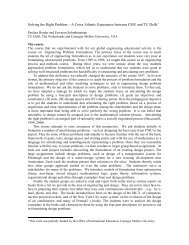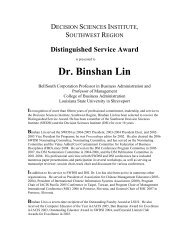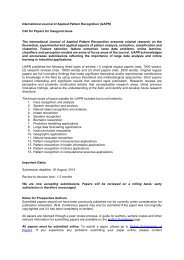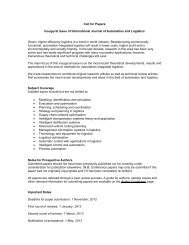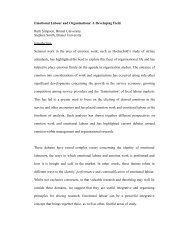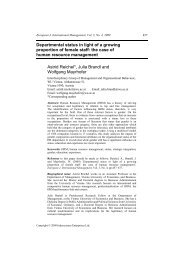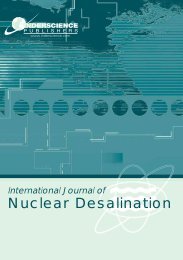A new Zeitgeist for international business activity and ... - InderScience
A new Zeitgeist for international business activity and ... - InderScience
A new Zeitgeist for international business activity and ... - InderScience
Create successful ePaper yourself
Turn your PDF publications into a flip-book with our unique Google optimized e-Paper software.
284 J.H. Dunning<br />
not only have these entities been joined by others – notably those comprising civil<br />
society – but their attitudes <strong>and</strong> actions have been increasingly influenced by constituents<br />
outside their immediate sphere of governance.<br />
Nowhere is this more clearly seen than in the increasing activism of consumer <strong>and</strong><br />
investor groups, <strong>and</strong> that of the stewardship voice, in influencing the objectives <strong>and</strong><br />
behaviour of firms. At the same time, as exemplified by regional integration schemes<br />
<strong>and</strong> the reconfiguration of the Bretton Woods organisations <strong>and</strong> the UN, supranational<br />
entities are also undergoing their own institutional soul searching (Stiglitz, 2002).<br />
Yet, we would suggest the metamorphosis is even more marked in the domain of IB<br />
<strong>activity</strong>. First, as we have already seen, a variety of <strong>new</strong> types of <strong>for</strong>eign direct investors<br />
are emerging, e.g., born global, equity fund managers, migrating small <strong>business</strong>es.<br />
Second, the <strong>for</strong>m of FDI is changing, with acquisitions <strong>and</strong> mergers A&Ms (relative to<br />
greenfield ventures) playing a more important role. Third, within MNEs, <strong>and</strong> particularly<br />
within globally integrated MNEs, there is more subsidiarity in decision taking<br />
(Birkinshaw <strong>and</strong> Hood, 1998). Fourth, the competitiveness of MNEs is being increasingly<br />
influenced by the alliances they conclude with <strong>for</strong>eign firms, <strong>and</strong> the networks <strong>and</strong>/or<br />
industrial clusters in which they participate. As Doz et al. (2001) have observed, the<br />
range of MNEs has widened from the very small <strong>and</strong> regional, to the very large <strong>and</strong><br />
global. This latter group of firms they identify as metanationals whose competitive or<br />
ownership specific advantages primarily rest in their willingness <strong>and</strong> ability to identify,<br />
access or create different kinds of income generating assets from across the globe, <strong>and</strong><br />
orchestrate these in a way that advances their own particular global strategies.<br />
In short, the actors now engaged in IB <strong>activity</strong> have become more varied, more<br />
multipurpose <strong>and</strong> more multifaceted. This, we would aver, points to the need <strong>for</strong> a <strong>new</strong><br />
<strong>and</strong> deeper <strong>Zeitgeist</strong> of the institutional symmetry <strong>and</strong> cooperation among <strong>and</strong> between<br />
the constituents of cross-border value-creating activities, if the benefits of such activities<br />
are to be fully <strong>and</strong> effectively captured.<br />
4 The environment <strong>for</strong> IB <strong>activity</strong> <strong>and</strong> scholarship<br />
Our conclusion then is that, between them, the <strong>new</strong> issues, <strong>new</strong> mindsets <strong>and</strong> <strong>new</strong><br />
actors identified make up something approaching a <strong>new</strong> <strong>Zeitgeist</strong> <strong>for</strong> IB <strong>activity</strong> <strong>and</strong><br />
scholarship. But exactly what are the implications of this <strong>Zeitgeist</strong> <strong>for</strong> the main actors<br />
<strong>and</strong> researchers?<br />
Here, we think it useful to distinguish between the two main attributes of the global<br />
l<strong>and</strong>scape underpinning <strong>and</strong> fashioning IB <strong>activity</strong>.<br />
The first is the Physical Environment (PE) <strong>and</strong> the second is the Human Environment<br />
(HE) faced by them. Essentially, the <strong>for</strong>mer is concerned with the extent to which <strong>and</strong><br />
ways in which firms create <strong>and</strong> deploy the scarce resources <strong>and</strong> capabilities available to<br />
them, <strong>and</strong> their seeking out <strong>and</strong> exploitation of the appropriate input <strong>and</strong> output markets<br />
(RCM). Most neoclassical studies of the wealth creating process either take the HE as<br />
given, or drastically simplify its contents (Matthews, 1986). But, in addition, we would<br />
underline the importance of the HE, which embraces all the <strong>for</strong>mal <strong>and</strong> in<strong>for</strong>mal<br />
incentive structures <strong>and</strong> en<strong>for</strong>cement mechanisms affecting the cognition, intentions,<br />
strategies <strong>and</strong> behaviour of individuals <strong>and</strong> organisations. We would further hypothesise<br />
that, as a direct result of globalisation, the content <strong>and</strong> quality of the HE has become<br />
a relatively more important determinant of the economic success of countries <strong>and</strong> firms.




